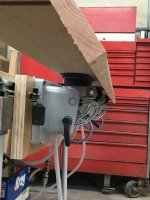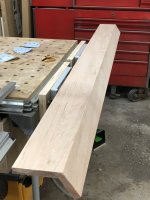You are correct sir. I think [member=4105]tjbnwi[/member] provides a great illustration of what the Domino can do for you. Could the biscuit joiner do the same thing? Yes, but without the assurance that those angles will line up because of the play inherent in biscuits. And try making a narrow frame and panel door with ff biscuits.
Factor into your costs, though, buying the Domino assortment systainer though, which gives you all the sizes as well as all the cutters. It's worth it.
I'm not as convinced about the value of the set, though. I used the cross stop the first few times when I was edge joining some panels, but found pencil marks to be just as efficient, and eventually sold the cross stop. The cross stop might be useful if you're in a production environment, but for single projects I don't think it saves time after accounting for setup and removal. I used the trim stop a lot more when I first got the machine, but honestly, I haven't employed it in almost a year, and in that time I've mortised plenty of narrow pieces, simply using scraps next to the workpiece to balance the machine. I don't like how it's not self-centering [EDIT: Hey [member=191]Rick Christopherson[/member] how about that update to the SCG?], and so if you are doing narrow mortises, you have to spend a lot of time fiddling with the settings to get it centered on the board. I'm not saying it's worthless, but it's a lot less useful than I thought it would be at first.
In the end, because of the cost savings, it may be worth it just to get the set for those few times when the trim stop is called for, rather than buying the trim stop separately at some later date.
sofa_king_rad said:
For me, I'm a hobbyist and while money isn't endless, I'm willing to spend some money if it means I can save significant time building products. My time is often very limited, so a timer saver item can mean something gets done In a weekend vs possibly a month.
Plus I'm a noob, while I will be playing wth hand tools and making old school traditional joints simply for getting a better feel for this type of work, i still have projects to build and the more and more I put plans together, a domino seems like the best way to avoid pocket screws but build in a similar amount of time.
Am I correct?


